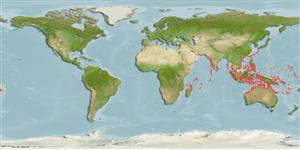>
Gobiiformes (Gobies) >
Gobiidae (Gobies) > Gobiinae
Etymology: Trimma: Greek, trimma, -atos = something crushed (Ref. 45335).
Eponymy: Dr Stefan Meiring Naudé (1904–1985) was a South African physicist who was Professor of Physics at Stellenbosch University (1934–1946). [...] (Ref. 128868), visit book page.
More on author: Smith.
Environment: milieu / climate zone / depth range / distribution range
экология
морской ассоциированный с рифами; пределы глубины 3 - 30 m (Ref. 1602), usually 3 - 30 m (Ref. 27115). Tropical; 22°C - 26°C (Ref. 27115); 30°N - 22°S
Indo-West Pacific: Seychelles, Aldabra, Chagos Islands, Ryukyu Islands, and Loyalty Islands; Mariana and Marshall islands in Micronesia.
Size / Вес / Возраст
Maturity: Lm ? range ? - ? cm
Max length : 3.5 cm SL самец/пол неопределен; (Ref. 48637)
Краткое описание
определительные ключи | морфология | морфометрия
колючие лучи спинного плавника (общее число) : 7; членистые (мягкие) лучи спинного плавника (общее число) : 7 - 8; колючие лучи анального плавника: 1; членистые (мягкие) лучи анального плавника: 7 - 9. Diagnosis: a frontal ridge behind the orbits that slopes steeply into a wide interorbital trench
anteromedially, and into postorbital trenches laterally; posterior nasal opening separate from eye; second spine of first dorsal fin elongate, third spine occasionally elongate; fifth pelvic fin ray branched once dichotomously; body color orange-red with seven dorsolateral white spots
between posterodorsal margin of the peduncle and origin of first dorsal, and with four ventrolateral spots between posteroventral margin of peduncle and origin of last anal ray; facial pattern uniform dusky orange-grey colour under orbit, with an orange vertical blotch, edged in melanophores on vertical limb of the preopercle resembling a club; conspicuous bar of melanophores extending vertically across posterior margin of pectoral base (Ref. 57688).
Occurs in lagoons and seaward reefs; on rubble and reef rock (Ref. 1602); also over coral patches interspaced with fine sandy bottoms, occasionally form small schools (Ref. 37688). Feeds on copepods, ostracods, and radiolarians (Ref. 1602).
Life cycle and mating behavior
половая зрелость | размножение | нерест | икра | Fecundity | личинки
Myers, R.F., 1991. Micronesian reef fishes. Second Ed. Coral Graphics, Barrigada, Guam. 298 p. (Ref. 1602)
Статус Красного Списка МСОП (Ref. 130435: Version 2024-2)
Угроза для людей
Harmless
Использование человеком
рыболовство: коммерческий; аквариум: коммерческий
дополнительная информация
инструменты
Специальные отчеты
Скачать в формате XML
ресурсы в Интернет
Estimates based on models
Preferred temperature (Ref.
123201): 25.3 - 29, mean 28 °C (based on 1090 cells).
Phylogenetic diversity index (Ref.
82804): PD
50 = 0.5000 [Uniqueness, from 0.5 = low to 2.0 = high].
Bayesian length-weight: a=0.01023 (0.00477 - 0.02194), b=3.01 (2.83 - 3.19), in cm total length, based on LWR estimates for this (Sub)family-body shape (Ref.
93245).
Trophic level (Ref.
69278): 3.3 ±0.42 se; based on food items.
устойчивость к внешним воздействиям (Ref.
120179): высокий, минимальное время удвоения популяции до 15 месяцев (Preliminary K or Fecundity.).
Fishing Vulnerability (Ref.
59153): Low vulnerability (10 of 100).
Nutrients (Ref.
124155): Calcium = 263 [124, 654] mg/100g; Iron = 1.28 [0.61, 2.50] mg/100g; Protein = 18.3 [16.3, 20.0] %; Omega3 = 0.174 [0.069, 0.381] g/100g; Selenium = 24.6 [10.2, 55.9] μg/100g; VitaminA = 147 [39, 539] μg/100g; Zinc = 3.11 [1.90, 4.84] mg/100g (wet weight);
